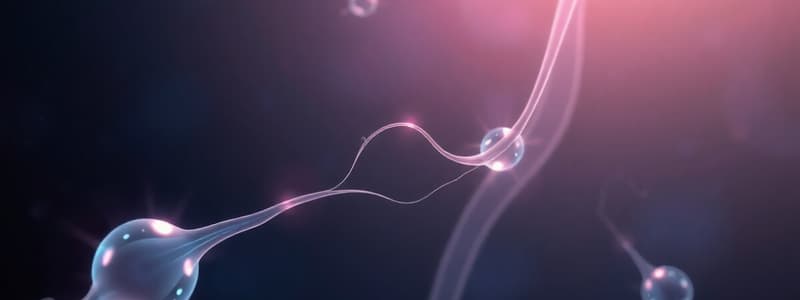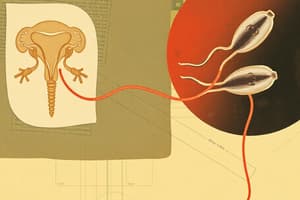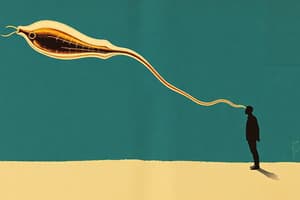Podcast
Questions and Answers
Where does fertilization typically occur in mammals?
Where does fertilization typically occur in mammals?
- The uterus
- The isthmus of the uterine tube
- The fimbria
- The ampulla of the uterine tube (correct)
What is the typical timeframe for fertilization to occur after ovulation?
What is the typical timeframe for fertilization to occur after ovulation?
- 24-48 hours
- 1-2 hours
- 6-12 hours (correct)
- 1-3 days
In dogs, at what stage of meiosis is the oocyte ovulated?
In dogs, at what stage of meiosis is the oocyte ovulated?
- Telophase II
- Metaphase II
- Anaphase I
- Prophase I (correct)
Where does the maturation of the oocyte complete in dogs?
Where does the maturation of the oocyte complete in dogs?
What is the role of fimbriae in the fertilization process?
What is the role of fimbriae in the fertilization process?
What is the key function of epididymal transit in sperm fertilization ability?
What is the key function of epididymal transit in sperm fertilization ability?
Where do sperm adhere in the female reproductive tract to prolong their lifespan?
Where do sperm adhere in the female reproductive tract to prolong their lifespan?
What type of changes are required for sperm capacitation in the female tract?
What type of changes are required for sperm capacitation in the female tract?
What membrane component change is associated with sperm hypermotility during capacitation?
What membrane component change is associated with sperm hypermotility during capacitation?
What is the primary function of the acrosome reaction during fertilization?
What is the primary function of the acrosome reaction during fertilization?
What extracellular structure of the oocyte does the sperm initially interact with during fertilization?
What extracellular structure of the oocyte does the sperm initially interact with during fertilization?
What is the significance of ZP3 during fertilization?
What is the significance of ZP3 during fertilization?
What event must occur before a sperm can fuse with the oocyte?
What event must occur before a sperm can fuse with the oocyte?
What is the function of cortical granules in the oocyte following fertilization?
What is the function of cortical granules in the oocyte following fertilization?
In fertilization, what is contained within the pronucleus?
In fertilization, what is contained within the pronucleus?
What structure from the sperm eventually forms one of the zygote's centrioles?
What structure from the sperm eventually forms one of the zygote's centrioles?
What event characterizes early embryo development?
What event characterizes early embryo development?
At what stage does zygotic protein synthesis begin during early embryo development?
At what stage does zygotic protein synthesis begin during early embryo development?
How do cells get metabolic support during early embryonic stages?
How do cells get metabolic support during early embryonic stages?
What is a key event that defines the hatched blastocyst stage?
What is a key event that defines the hatched blastocyst stage?
What is the composition of the amniotic fluid?
What is the composition of the amniotic fluid?
Which of the following is a function of the allantois?
Which of the following is a function of the allantois?
After sperm penetration into the oocyte, what event immediately follows?
After sperm penetration into the oocyte, what event immediately follows?
What is the primary function of maternal recognition of pregnancy?
What is the primary function of maternal recognition of pregnancy?
How does maternal recognition of pregnancy occur in ruminants?
How does maternal recognition of pregnancy occur in ruminants?
How does estradiol contribute to maternal recognition of pregnancy in swine?
How does estradiol contribute to maternal recognition of pregnancy in swine?
What role does embryo mobility play in maternal recognition of pregnancy in horses?
What role does embryo mobility play in maternal recognition of pregnancy in horses?
In the context of fertilization, which of the following accurately describes the term 'totipotent cells'?
In the context of fertilization, which of the following accurately describes the term 'totipotent cells'?
Which of the following mechanisms is directly involved in preventing polyspermy after the fusion of sperm and oocyte membranes?
Which of the following mechanisms is directly involved in preventing polyspermy after the fusion of sperm and oocyte membranes?
Which of the following statements correctly describes the role of calcium in the acrosome reaction?
Which of the following statements correctly describes the role of calcium in the acrosome reaction?
What is the significance of the 'sperm reservoir' in the context of fertilization?
What is the significance of the 'sperm reservoir' in the context of fertilization?
Which structure is directly responsible for transporting only fertilized zygotes through the uterine tubes in mares?
Which structure is directly responsible for transporting only fertilized zygotes through the uterine tubes in mares?
What is the likely consequence if the release of soluble factors and DNA by the sperm into the perivitelline space fails during fertilization?
What is the likely consequence if the release of soluble factors and DNA by the sperm into the perivitelline space fails during fertilization?
Which component of the sperm undergoes significant modification to facilitate membrane fusion with the oolemma?
Which component of the sperm undergoes significant modification to facilitate membrane fusion with the oolemma?
What critical implication arises if an equine conceptus is unable to maintain consistent mobility within the uterus during early pregnancy?
What critical implication arises if an equine conceptus is unable to maintain consistent mobility within the uterus during early pregnancy?
In a scenario where a researcher aims to bypass the need for sperm capacitation in in vitro fertilization, what direct intervention could most effectively promote acrosomal exocytosis?
In a scenario where a researcher aims to bypass the need for sperm capacitation in in vitro fertilization, what direct intervention could most effectively promote acrosomal exocytosis?
Flashcards
Ovulation
Ovulation
The release of the oocyte from the follicle.
Ampulla
Ampulla
The location where fertilization occurs within the uterine tube.
Prophase 1
Prophase 1
In dogs, oocytes ovulate at this specific phase of meiosis.
Sperm Capacitation
Sperm Capacitation
Signup and view all the flashcards
Zona Pellucida
Zona Pellucida
Signup and view all the flashcards
Acrosome Reaction
Acrosome Reaction
Signup and view all the flashcards
Blocks to Polyspermy
Blocks to Polyspermy
Signup and view all the flashcards
Pronucleus
Pronucleus
Signup and view all the flashcards
Cleavage
Cleavage
Signup and view all the flashcards
Hatching Blastocyst
Hatching Blastocyst
Signup and view all the flashcards
Maternal Recognition
Maternal Recognition
Signup and view all the flashcards
Interferon Tau
Interferon Tau
Signup and view all the flashcards
PGF2a
PGF2a
Signup and view all the flashcards
6 days after fertilization
6 days after fertilization
Signup and view all the flashcards
Study Notes
Ovulation
- The oocyte is released from the follicle
- Oocyte and cumulus mass are moved by fimbria into the infundibulum of the uterine tube
- Meiosis continues to second meiotic metaphase, but is blocked unless fertilisation occurs
- Fertilization happens in the ampulla of the uterine tube
- Short window for fertilization, lasting 6-12 hours
Ovulation in dogs
- Oocytes ovulate at Prophase 1
- This is Before completion of meiosis 1
- Maturation finishes in the oviduct
Fertilisation - Sperm Transit
- Sperm gain the ability to fertilize during the epididymal transit
- Sperm move from the site of deposition (insemination x natural mating) to the uterine tube within minutes or hours
- Contractions of the female tract occur
- Millions or billions of sperm are ejaculated
- About a thousand reach the uterine tube
- Only hundreds are present for fertilization
Sperm Reservoir
- The isthmus of the uterine tube is the sperm reservoir
- It is near the uterotubal junction
- Sperm adhere to the tubal epithelium
- There is intimate junction with cell membrane interaction
- Adherent sperm have a prolonged lifespan
- Sperm are released at the time of ovulation
- The release mechanism is unknown
Sperm Capacitation
- Sperm become capable of undergoing acrosome reaction
- There are biochemical (non-morphologic) changes required in the female tract before sperm are capable of fertilization
- Seminal plasma components are removed and interaction with female secretions occur
- Hypermotility of the sperm occurs and there are changes in membrane cholesterol, gylcosaminoglycans which affect membrane fluidity
- Oocyte receptor expression occurs
Acrosome Reaction
- It's essential for fertilization, and allows sperm penetration into the oocyte
- It's calcium dependent
- It usually occurs when sperm contact the zona pellucida of the oocyte
- In some species, it occurs during cumulus penetration
- Allows fusion of the sperm plasma membrane with the outer acrosomal membrane
- Extensive vesiculation occurs over the surface of the sperm and acrosome
- Allows the orderly release of acrosomal enzymes
Fertilisation, Penetration of Zona Pellucida
- Sperm migrate between cumulus cells
- They attach to and migrate through the zona pellucida
- Fusion of the sperm and oocyte membrane occurs
- The zona pellucida has 3 major proteins
- ZP3 is the specific binding site for sperm
- Only acrosome-intact sperm bind to the zona
- Sperm motility and enzymes are required for zona penetration (e.g. acrosine)
Fertilisation, Gamete Fusion
- The oocyte membrane (vitelline membrane) is less species-specific in binding than the ZP
- Completion of the acrosome reaction is required before sperm can fuse with oocytes
- Fusion involves the post-acrosomal sperm membrane (equatorial region)
- It becomes fused ("intermingled") with the oolemma
Blocks to Polyspermy
- The zona pellucida becomes impermeable upon fertilization
- Extensive reorganisation of the ZP structure
- This is driven by oocyte cortical granules released into the perivitelline space, after the release of soluble factors and DNA
Fertilisation, After Sperm Penetration
- The Oocyte completes meiosis
- Expels the second polar body
- Remaining maternal (haploid) chromosomes are enclosed in the pronucleus
- The sperm nuclear envelope disintegrates
- DNA decondensation occurs
- A new envelope of male pronucleus is formed
- Male and female pronuclei migrate to the egg cell center
- The nuclear envelopes disperse
- Intermixing (fusion) of chromosomes occurs
- Chromosomes aggregate in prophase of the first cleavage division
- The proximal centriole of sperm forms one of the zygote’s centrioles
Early embryo development
- Early cleavage occurs in the uterine tubes
- The zygote reaches the uterus:
- In about 4 days in cows and most other species
- Longer in horses, 6 days
- Longer in dogs, 8 days
- 16-cell/compact morula stage (cows, sheep)
- Morula/early blastocyst (mares and dogs)
Mares
- Only fertilized zygotes are transported through the uterine tubes (oviductal papilla)
- The zygote is responsible for transport by secretion of PGE2
Early Embryo Development
- Several mitotic divisions occur
- Early divisions occur without increase in cell mass
- "Cleavage" (or “Reduction Division”)
- Metabolic support is provided by maternal secretions
- Zygotic protein synthesis begins at 2 to 16-cell stage depending on species, totipotent cells
Hatched Blastocyst
- The blastocyst hatches out from the zona pellucida, the beginning of implantation
- There is an increase in fluid in the blastocele
- Proteolytic enzymes come from the trophoblast
- Blastocysts experience Contraction
Timings for Species
- Most species hatching occurs in 7-10 days
- Mares hatching occurs in 9-10 days, however, equine embryos have a capsule surrounding the ZP, therefore, the rounded shape is maintained
Important Early Events
- Development inside the zona pellucida occurs
- Hatching from the ZP occurs
- Maternal recognition of pregnancy
- Formation of extraembryonic membranes:
- Yolk sac is for nutrition and sex differentiation
- Amnion amniotic fluid provides mechanic protection, hydration, temperature changes and fetus movement
- Allantois collects secretions from the embryo and helps with gases exchanges
- Chorion is the outermost fetal membrane which attaches with the uterus and provides nutrition to the embryo.
Maternal Recognition of Pregnancy
-
It is critical in that the mother "recognizes" that she is pregnant
-
The major consequence is to prolong the period of function of the corpus luteum
-
It is a transition from a cyclic to pregnant state
-
Different processes are used in each species
- Two major strategies
- Anti-luteolytic which consists of Diversion or Inhibition of PGF2α secretion
- Luteotropic which consists of maintaining the CL (e.g. hCG in humans)
- Two major strategies
-
The Pregnant and non-pregnant cycle are similar for the first 14-16 days
-
The mechanism isn't completely understood in mares - Embryo mobility is seen in horses - Interferon tau (IFNT) is seen in cows and sheep - Estrogens are seen in pigs - Chorionic gonadotropin is seen in primates
Maternal Recognition of Pregnancy in Ruminants
- After hatching from the zona pellucida, the blastocyst elongates
- The blastocyst contacts most of the uterine luminal epithelium
- Trophoectoderm (future "placenta”) produces Interferon tau (IFNτ)
- IFNτ Inhibits oxytocin receptor synthesis and Inhibits prostaglandin F2α
- IFNτ Stimulates the endometrial glands
Maternal Recognition of Pregnancy in Swine
- The blastocyst produces Estradiol
- Estradiol changes direction of PGF2α secretion by the endometrium:
- Endometrial-derived PGF2α is directed away from the uterine vasculature (endocrine secretion) and sequestration into the uterine lumen (exocrine secretion)
- PGF2α is inactivated in the lumen or PGF2α is metabolized to its inactive 13, 14-dihydro-15-keto prostaglandin F2α metabolite
Maternal Recognition of Pregnancy in Horses
- Embryo mobility is present
- Fertilization happens in the uterine tube
- The viable embryo enters the uterus around day 6 after fertilization: this marks first maternal recognition of pregnancy and transport depends on PGE2
- The Equine embryo migrates through both uterine horns and body several times a day, up to 18 horn changes per day
- Movement is mediated by the uterus: although, if there are simulated fake vesicles then movement is less. Movement is maximal around days 10 – 12 and some signal from the embryo occurs (PGE)?
- The prevention of movement results in pregnancy loss
Studying That Suits You
Use AI to generate personalized quizzes and flashcards to suit your learning preferences.




